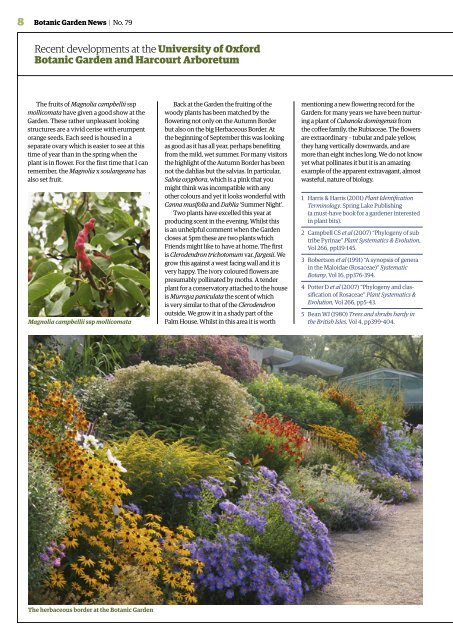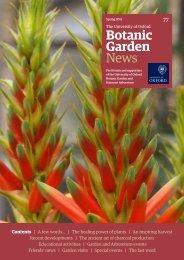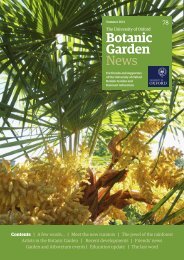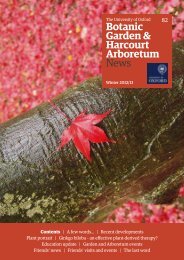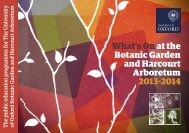Autumn/Winter 2011/12 - Harcourt Arboretum - University of Oxford
Autumn/Winter 2011/12 - Harcourt Arboretum - University of Oxford
Autumn/Winter 2011/12 - Harcourt Arboretum - University of Oxford
Create successful ePaper yourself
Turn your PDF publications into a flip-book with our unique Google optimized e-Paper software.
8<br />
Botanic Garden News | No. 79<br />
Recent developments at the <strong>University</strong> <strong>of</strong> <strong>Oxford</strong><br />
Botanic Garden and <strong>Harcourt</strong> <strong>Arboretum</strong><br />
The fruits <strong>of</strong> Magnolia campbellii ssp<br />
mollicomata have given a good show at the<br />
Garden. These rather unpleasant looking<br />
structures are a vivid cerise with erumpent<br />
orange seeds. Each seed is housed in a<br />
separate ovary which is easier to see at this<br />
time <strong>of</strong> year than in the spring when the<br />
plant is in flower. For the first time that I can<br />
remember, the Magnolia x soulangeana has<br />
also set fruit.<br />
Magnolia campbellii ssp mollicomata<br />
Back at the Garden the fruiting <strong>of</strong> the<br />
woody plants has been matched by the<br />
flowering not only on the <strong>Autumn</strong> Border<br />
but also on the big Herbaceous Border. At<br />
the beginning <strong>of</strong> September this was looking<br />
as good as it has all year, perhaps benefiting<br />
from the mild, wet summer. For many visitors<br />
the highlight <strong>of</strong> the <strong>Autumn</strong> Border has been<br />
not the dahlias but the salvias. In particular,<br />
Salvia oxyphora, which is a pink that you<br />
might think was incompatible with any<br />
other colours and yet it looks wonderful with<br />
Canna musifolia and Dahlia ‘Summer Night’.<br />
Two plants have excelled this year at<br />
producing scent in the evening. Whilst this<br />
is an unhelpful comment when the Garden<br />
closes at 5pm these are two plants which<br />
Friends might like to have at home. The first<br />
is Clerodendron trichotomum var. fargesii. We<br />
grow this against a west facing wall and it is<br />
very happy. The ivory coloured flowers are<br />
presumably pollinated by moths. A tender<br />
plant for a conservatory attached to the house<br />
is Murraya paniculata the scent <strong>of</strong> which<br />
is very similar to that <strong>of</strong> the Clerodendron<br />
outside. We grow it in a shady part <strong>of</strong> the<br />
Palm House. Whilst in this area it is worth<br />
mentioning a new flowering record for the<br />
Garden: for many years we have been nurturing<br />
a plant <strong>of</strong> Cubanola domingensis from<br />
the c<strong>of</strong>fee family, the Rubiaceae. The flowers<br />
are extraordinary – tubular and pale yellow,<br />
they hang vertically downwards, and are<br />
more than eight inches long. We do not know<br />
yet what pollinates it but it is an amazing<br />
example <strong>of</strong> the apparent extravagant, almost<br />
wasteful, nature <strong>of</strong> biology.<br />
1 Harris & Harris (2001) Plant Identification<br />
Terminology. Spring Lake Publishing<br />
(a must-have book for a gardener interested<br />
in plant bits).<br />
2 Campbell CS et al (2007) “Phylogeny <strong>of</strong> sub<br />
tribe Pyrinae” Plant Systematics & Evolution,<br />
Vol 266, pp119-145.<br />
3 Robertson et al (1991) “A synopsis <strong>of</strong> genera<br />
in the Maloidae (Rosaceae)” Systematic<br />
Botany, Vol 16, pp376-394.<br />
4 Potter D et al (2007) “Phylogeny and classification<br />
<strong>of</strong> Rosaceae” Plant Systematics &<br />
Evolution, Vol 266, pp5-43.<br />
5 Bean WJ (1980) Trees and shrubs hardy in<br />
the British Isles, Vol 4, pp399-404.<br />
The herbaceous border at the Botanic Garden


